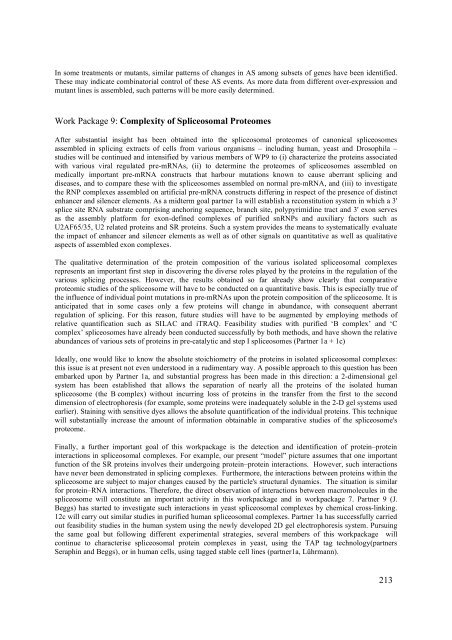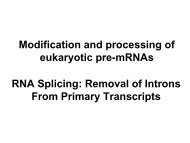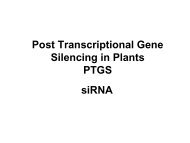You also want an ePaper? Increase the reach of your titles
YUMPU automatically turns print PDFs into web optimized ePapers that Google loves.
In some treatments or mutants, similar patterns of changes in AS among subsets of genes have been identified.These may indicate combinatorial control of these AS events. As more data from different over-expression andmutant lines is assembled, such patterns will be more easily determined.Work Package 9: Complexity of Spliceosomal ProteomesAfter substantial insight has been obtained into the spliceosomal proteomes of canonical spliceosomesassembled in splicing extracts of cells from various organisms – including human, yeast and Drosophila –studies will be continued and intensified by various members of WP9 to (i) characterize the proteins associatedwith various viral regulated pre-mRNAs, (ii) to determine the proteomes of spliceosomes assembled onmedically important pre-mRNA constructs that harbour mutations known to cause aberrant splicing anddiseases, and to compare these with the spliceosomes assembled on normal pre-mRNA, and (iii) to investigatethe RNP complexes assembled on artificial pre-mRNA constructs differing in respect of the presence of distinctenhancer and silencer elements. As a midterm goal partner 1a will establish a reconstitution system in which a 3'splice site RNA substrate comprising anchoring sequence, branch site, polypyrimidine tract and 3' exon servesas the assembly platform for exon-defined complexes of purified snRNPs and auxiliary factors such asU2AF65/35, U2 related proteins and SR proteins. Such a system provides the means to systematically evaluatethe impact of enhancer and silencer elements as well as of other signals on quantitative as well as qualitativeaspects of assembled exon complexes.The qualitative determination of the protein composition of the various isolated spliceosomal complexesrepresents an important first step in discovering the diverse roles played by the proteins in the regulation of thevarious splicing processes. However, the results obtained so far already show clearly that comparativeproteomic studies of the spliceosome will have to be conducted on a quantitative basis. This is especially true ofthe influence of individual point mutations in pre-mRNAs upon the protein composition of the spliceosome. It isanticipated that in some cases only a few proteins will change in abundance, with consequent aberrantregulation of splicing. For this reason, future studies will have to be augmented by employing methods ofrelative quantification such as SILAC and iTRAQ. Feasibility studies with purified ‘B complex’ and ‘Ccomplex’ spliceosomes have already been conducted successfully by both methods, and have shown the relativeabundances of various sets of proteins in pre-catalytic and step I spliceosomes (Partner 1a + 1c)Ideally, one would like to know the absolute stoichiometry of the proteins in isolated spliceosomal complexes:this issue is at present not even understood in a rudimentary way. A possible approach to this question has beenembarked upon by Partner 1a, and substantial progress has been made in this direction: a 2-dimensional gelsystem has been established that allows the separation of nearly all the proteins of the isolated humanspliceosome (the B complex) without incurring loss of proteins in the transfer from the first to the seconddimension of electrophoresis (for example, some proteins were inadequately soluble in the 2-D gel systems usedearlier). Staining with sensitive dyes allows the absolute quantification of the individual proteins. This techniquewill substantially increase the amount of information obtainable in comparative studies of the spliceosome'sproteome.Finally, a further important goal of this workpackage is the detection and identification of protein–proteininteractions in spliceosomal complexes. For example, our present “model” picture assumes that one importantfunction of the SR proteins involves their undergoing protein–protein interactions. However, such interactionshave never been demonstrated in splicing complexes. Furthermore, the interactions between proteins within thespliceosome are subject to major changes caused by the particle's structural dynamics. The situation is similarfor protein–RNA interactions. Therefore, the direct observation of interactions between macromolecules in thespliceosome will constitute an important activity in this workpackage and in workpackage 7. Partner 9 (J.Beggs) has started to investigate such interactions in yeast spliceosomal complexes by chemical cross-linking.12c will carry out similar studies in purified human spliceosomal complexes. Partner 1a has successfully carriedout feasibility studies in the human system using the newly developed 2D gel electrophoresis system. Pursuingthe same goal but following different experimental strategies, several members of this workpackage willcontinue to characterise spliceosomal protein complexes in yeast, using the TAP tag technology(partnersSeraphin and Beggs), or in human cells, using tagged stable cell lines (partner1a, Lührmann).213







